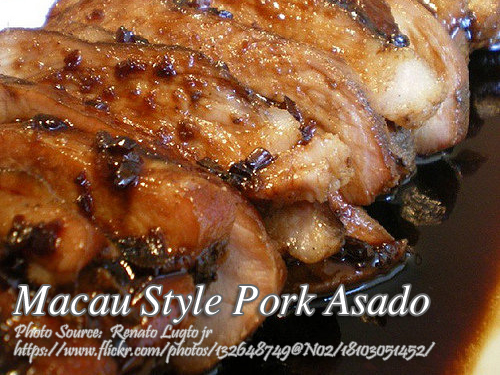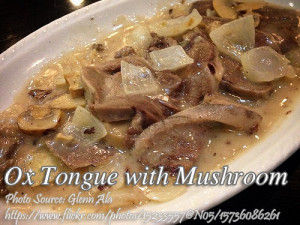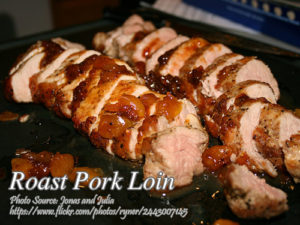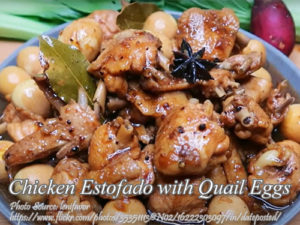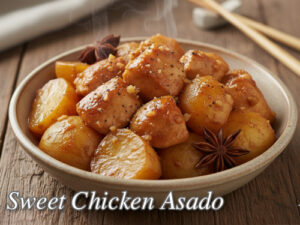This pork asado Macau style require only just combining the ingredients together and cooking the pork meat until tender. No need to roast or broil the pork to make a Chinese style pork asado. Just combine the pork, soy sauce, sugar, peppercorns, salt, bay leaf, garlic, anise, water and mushrooms. Then cook until the meat is tender. Garnish with cashew nuts, parsley or spring onions.
Pork Asado Macau Style: A Sunday Favorite From My Uncle Tony
Growing up in Tondo, our Sundays weren’t complete without my Uncle Tony banging pots in the kitchen while blasting Freddie Aguilar from the radio. He was the type who cooked by instinct, not measurement, and one of his signature dishes was this pork asado Macau style. He picked up the recipe during the ’80s, when he worked as a seaman and docked in Hong Kong and Macau. According to him, this version was popular in small cha chaan teng diners – the kind with plastic stools and strong jasmine tea.
Uncle Tony loved the simplicity of it. No roasting, no broiling, no extra steps. “Basta pagsamasamahin mo lang lahat,” he’d say, waving a wooden spoon like a maestro. He was right. This dish is as straightforward as it is flavorful. You just combine pork belly, soy sauce, brown sugar, peppercorns, salt, bay leaves, garlic, star anise, dried mushrooms, and a splash of water. Let it boil and then simmer away until the pork becomes melt-in-your-mouth tender and the sauce thickens to a rich, savory glaze.
Why This Macau Style Pork Asado Works
At first glance, it might look like your regular adobo or humba, but this pork asado Macau style hits differently. It’s the dried mushrooms and star anise that bring in that distinct Chinese aroma. The mushrooms soak up the sauce and burst with umami in every bite. Star anise, on the other hand, adds that subtle licorice note that gives the dish its unique edge.
Unlike traditional Chinese char siu that requires roasting or broiling, this method is all about slow simmering. The low and slow cooking technique allows the pork fat to render gently, enriching the sauce without drying out the meat. It’s perfect for beginners because there’s very little room to mess it up.
Another trick from Uncle Tony: don’t skip the MSG. It may be controversial in some circles, but in Filipino-Chinese households, it’s just another spice on the rack. Used sparingly, it rounds out the flavor and enhances the dish’s savory depth.
A Little History on Pork Asado Macau Style
Asado has many faces across the Philippines. In Pampanga, it leans sweet and saucy. In Batangas, it can be dry and peppery. But this Macau-style version? It carries the fingerprints of Chinese migration and culinary fusion. Macau itself is a melting pot of Portuguese and Cantonese cuisines, so it’s no surprise that their take on pork asado involves bold spices, soy, and a balance of sweet and salty.
My cousin Liza once visited Macau during a layover and told me how surprised she was to find a dish so familiar in such a faraway place. “Parang luto ni Tito Tony,” she said, laughing over video call. Turns out, flavors travel farther than we think.
Garnish and Pairings Matter
When the pork is fall-apart tender and the sauce clings like velvet, you know it’s ready. Uncle Tony used to toss in a handful of cashew nuts right before serving for crunch. He’d then garnish the platter with chopped parsley or spring onions. It may sound like a small thing, but that pop of green makes the whole dish come alive.
The best way to eat this? With pickled papaya or “atchara” on the side. The sweet-sour contrast cuts through the richness and resets your palate between bites.
Perfect for Beginners, Loved by All
One of the reasons this pork asado Macau style remains a staple in our home is its foolproof process. There are no complicated steps, no intimidating techniques. It’s a perfect entry point for anyone learning Filipino-Chinese dishes. If you can boil, you can make this.
My younger brother Nestor made this as his first-ever ulam when he moved into his condo in Pasig. He called me halfway through, panicking that the sauce was drying up. “Add more water and lower the heat,” I told him. An hour later, he sent me a photo. It wasn’t perfect, but he nailed the flavor. And that’s the beauty of this dish—it’s forgiving.
Final Thoughts
Whether you’re recreating a dish from memory, experimenting with Filipino-Chinese flavors, or simply looking for something hearty and nostalgic, this pork asado Macau style deserves a spot in your kitchen. From my Uncle Tony’s Tondo kitchen to yours, it’s proof that sometimes, the best recipes are the ones that feel like home.
How to Cook Pork Asado Macau Style
Ingredients
- 1 kilo pork chops or spareribs
- 2 Tbsp. soy sauce
- 1/2 cup brown sugar pack
- 1 Tbsp. salt
- 1 Tbsp. peppercorns whole
- 1 cup water
- 1/2 pc bay leaf
- 5 cloves garlic minced
- 1 whole star anise or sanque
- 5 pcs dried mushrooms optional
- 1 tsp. MSG
- 1/2 cup toasted cashew nuts
Instructions
How to Cook Pork Asado Macau Style :
- Boil and simmer pork with all the ingredients (soy sauce, brown sugar, salt, peppercorns, water, bay leaves, garlic, star anise, dried mushrooms, MSG) except cashew nuts.
- If sauce dries and pork is not yet done, add more water.
- Boil over low fire until sauce thickens.
- Add cashew nuts when about to serve.
- Garnish with parsley or spring onions and cut into 2-inch long sprigs.
- Best when served with pickled papaya.
Notes
Cooking Tips:
Simmer Low and Slow for Tender Meat
Cooking over low heat allows the pork fat to render slowly, giving the sauce a rich, deep flavor while keeping the meat juicy. Rushing the process on high heat can make the meat tough and dry. Be patient—simmering low and slow is what makes this dish irresistibly tender.Soak Dried Mushrooms Before Cooking
To get the most flavor from the dried mushrooms, soak them in warm water for at least 20 minutes before adding to the pot. This not only rehydrates them but also enhances their earthy, umami flavor. You can even use the soaking liquid to replace part of the water in the recipe for added depth.Don't Skip the Final Garnish
Cashew nuts, parsley, or spring onions may seem optional, but they add essential contrast in texture and freshness. The crunch from the nuts and brightness from the herbs balance the rich, savory sauce. These little touches elevate the dish from everyday to extra special.
